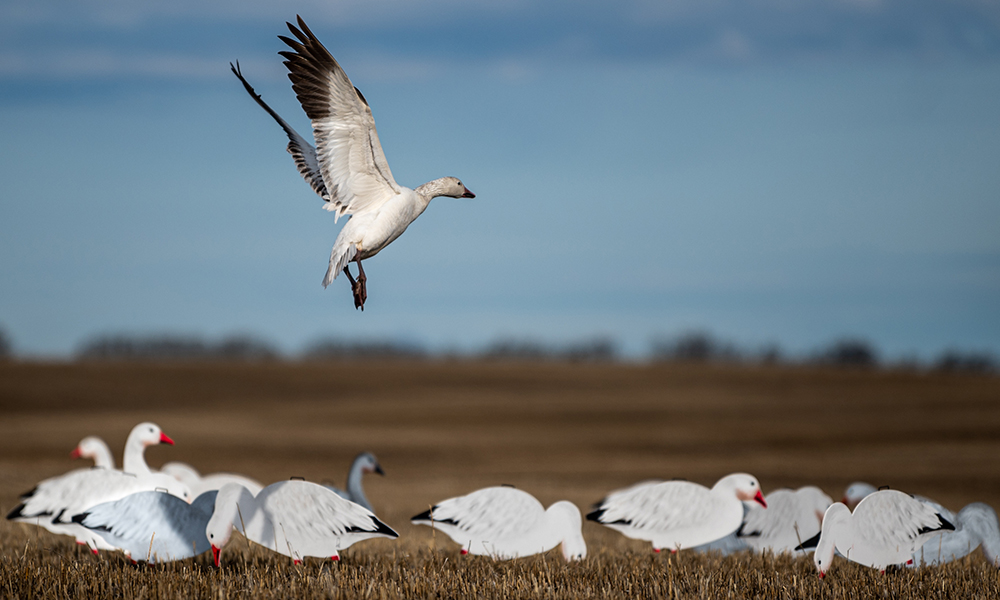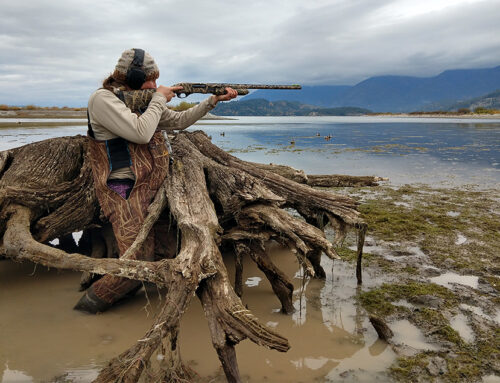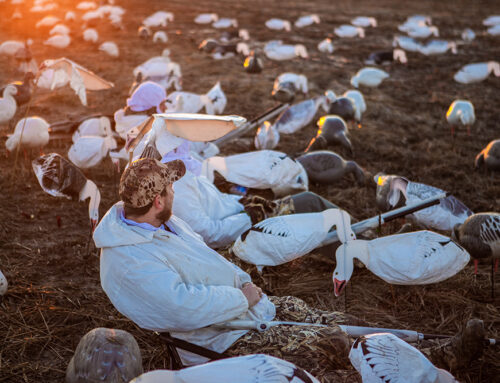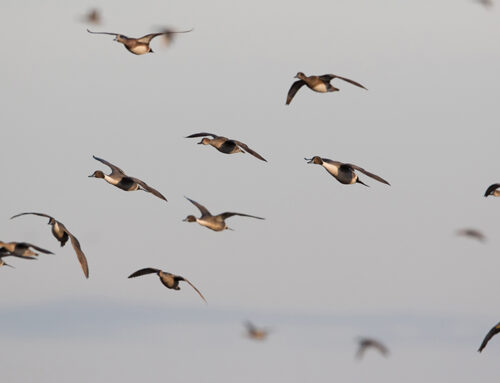Going Small for Snows
No trailer (or three) jam packed with snow goose decoys? S’no problem! Here’s how to make a smaller spread work this spring.
By M.D. Johnson
Eighteen hundred. Two thousand. I’m not sure what the exact number was … hell, I don’t even know if the young man who orchestrated the menagerie of plastic knew the exact number. What I did know was it was a lot of decoys. And battery-driven spinning things. And speakers to rival a Rolling Stones concert. A lot of stuff.
The young man—now much better known—was Tony Vandemore, co-owner of the Missouri-based Habitat Flats and an authority on white goose hunting. I’d joined Vandemore for early-season teal, wood duck, and mallard hunts, but this was my first experience with snows. So when the young man instructed us to get down and flicked the power switch, bringing to life eight speakers and a pair of rotary decoy machines, I listened. But when I finally saw the geese he was looking at—so far away they looked a lot like flecks of pepper on a paper plate—I wondered to myself, “What the hell is this kid doing?”
Moments later, and after taking my inaugural ride in the eye of a white goose hurricane, I realized he knew exactly what he was doing.
And so it was with my further experiences with snows in Missouri, Iowa, Nebraska, Kansas, and South Dakota—concert hall sound systems and a virtual sea of plastic. Fifteen hundred. Twenty-five hundred. But it wasn’t just me, for it seemed to most hunters that massive spreads and big numbers were the only way to go when it came to fooling spring snows.
“Either go big,” I was told time and time again by those foolish enough to chase white geese, “or don’t go at all.”
And that’s just the way it is … or is it?

Defining ‘Small’
Let’s begin by addressing perhaps the most challenging part of the small spreads for snows equation, that being the definition of the word “small.” For a group accustomed to setting 4,500 decoys, a mere thousand might be small; for those rigging 1,000, then 400 to 500 may fit the bill. Much of it, then, lies in what one’s used to. It’s an eye of the beholder sort of thing, I reckon.
“Downsizing for me is 300 to 500 full-bodies,” said Vandemore “We’ve done this quite a bit in Arkansas, and 300 full-bodies is what we typically run in Saskatchewan in the fall.”
Eleven hundred miles east of Vandemore’s digs in north-central Missouri lies Easton, Maryland, home to some of the nation’s deepest goose hunting traditions, as well as to legendary callmaker, Sean Mann. No stranger to geese, be they darks or lights, Mann is the mastermind behind the Eastern Shoreman goose call, one of the most recognizable hunting instruments ever to be crafted. But while the World Champion and Champion of Champions built his reputation on Canadas, he’s certainly no stranger to the ins and outs of spring snows.
“To me a small spring snow spread would be 300 decoys or fewer,” Mann said, “If I’m hunting a water hole, I may use as few decoys as three dozen floaters.”
That’s not to suggest committing the sin of shooting a roost, Mann continued, but rather, strategically targeting water where the birds are going to hydrate. In Maryland, says Mann, that means avoiding setups on alkali ponds, which birds will use to roost but won’t drink from. Dry-feeding snows must drink afterward to digest their food. Find their watering hole, and it won’t take a massive spread to find success.
Coming back around to the word “small,” Nick Costas, who owns Split Reed (splitreed.com) and Thunderbird Outfitters in Saskatchewan, is quick to admit he’s not a “spring snow grinder” like some folks, but he does his fair share of chasing the white fowl.
“For years, 100- to 150-dozen socks, rotary machines, clone decoys, fliers … the monster set-ups were the big thing,” Costas said. “And people still do it. They’re hunting a 10,000-bird feed. They’re laying in the decoys under the socks. A huge spread with a lot of motion: That’s their play.”
Costas was convinced to rethink this mindset during the spring 2018 season.
“That was a tough year for snows in Arkansas, the year I guided down there,” he explained. “There weren’t a lot of juvies. We came out running 100 dozen socks with rotaries, and didn’t have a lot of success. So, we started packing in layout blinds, with 300 full-bodies and no motion, and had success—forty- to 80-bird shoots. To me 300 full-bodies is a small spread.”
As importantly, it’s enough to work.
Dynamic Decoys
Now don’t get me wrong: I’m not saying there’s not a lot of thought that goes into setting out a 2,000 mixed rig of full-bodies, silhouettes, socks, rotary machines, fliers, layouts, A-frames, and anything else worthy of inclusion in these so-called “monster spreads.” There is! But I will say there’s a great deal more margin for error when setting 2,000 fakes as opposed to artistically arranging Mann’s 36 floaters or Costas’ 300 full-bodies, e.g. preparing for a wind shift, selecting blind locations, and most significantly, concealment to the point of invisibility.
“When I say ‘300 full-bodies,’ I would likewise run a small sock or silhouette spread, if that’s what I had,” Costas clarified. “Not everyone can afford 300 full-bodies … and if there was a consistent snow goose feed, I would have confidence running 300 silhouettes or socks, especially depending on the wind. I’m not the guy who’s going to say you need highly expensive decoys to kill snow geese. I don’t believe that.”
So is there a right way and a wrong way to set those 300 decoys, be they full-bodies, socks, or silhouettes?
“More thought definitely goes into setting a small snow spread than when I’m rigging 1,500 or more,” Vandemore said. “But it’s still a fairly routine configuration, with more on the upwind side and fewer downwind.”
Perhaps not surprisingly, Mann’s thoughts on the subject are similar to Vandemore’s, but with an added element which, to those who’ve spent time peering through a windshield, is quite understandable.
“I try to duplicate or set the exact picture of what I’d seen during my scouting,” Mann said. “The birds know where they want to be, and more importantly, why they want to be there. I don’t need to know why, but I do need to know where, how, and of course, when.”
Costas breaks a bit from the traditional “tight is better” theory of setting a snow goose spread, especially when he’s working with but a handful of decoys.
“I’m running my spread looser than most,” he said. “I’m creating a lot of little pockets, and giving the birds options where they can land.”
What the young man said next truly hit home.
“I know it’s not spring, but this works in the fall in Canada: I’ll run 10 dozen silhouettes, hide out of the spread, and kill tons of snow geese like that,” Costas said. “I’d say that’s a very small snow goose spread, but mind you, I’m running that when they’re coming to that exact field. My philosophy is that the more crap I put out there, the more opportunity I have to mess the situation up.”

Visibility and Acoustics
Sooner or later, be the rig large enough to cover several football fields or as small as the average driveway, a conversation surrounding spring snows will turn to the topics of sound and motion. Monster spreads often combine the motion and movement akin to a Mardi Gras parade. Constant sound. Spinning. Flapping. Flying. Flipping. Shaking. It’s like hunting geese in an enormous snow globe—with speakers blaring.

A small spread though, and the variables of sound and motion, change a touch.
“I’ll still use rotary machines in a small spread,” said Vandemore. “But I’ll put them on short posts close to the ground.”
In the East, Mann believes in the back and forth of his socks as it pertains to motion and is a firm believer in an old school motion tool.
“If I can be in the spread, I’ll use a square black and white flag for attraction and attention,” he said. “I’m not using it for constant motion, but to refocus birds when they’re headed my way. If they start to get bored, as evidenced by birds starting to fall out of the flock or even the entire bunch beginning to slide off, I’ll flip the flag and try to get them refocused.”
Sound is, of course, another variable in the small snow spread; however, here the question is whether to use electronics (e-callers) or to return to the tried-and-true mouth calls … or, both?
“You definitely still need the tunes (e-callers), but you really need to think about volume and lowering that when the birds get closer,” Vandemore said. “Often, I’ll still run two e-callers, but I can get away with one situationally. Don’t overlook the fact that 300 decoys cover a lot less real estate than do 1,000, so it matters where your sound is coming from and how much sound you’re putting out.”
Costas is on the same page with Vandemore when it comes to sound production.
“I adjust my e-caller volume, depending on the birds,” he said. “It’s just like (mouth) calling for ducks and geese—you’re going to be a little louder when you’re trying to get their attention versus when they’re finishing.”
Mann’s theory on the audible is different.
“Volume is often overdone with white geese,” he said. “Snows have great hearing, and they know what they want to hear. Sound quality is the most important aspect. You have to sound like them and know what they’re trying to say. It’s not just creating noise. It’s being a good family group of great-sounding birds.”
Further, Mann walks both sides of the e-call/mouth call fence in the spring.
“I like e-callers when allowed, with a very small group sound and four speakers,” he said. “I’m looking for the sound to ‘move’ around the speakers, as if the birds were talking across the flock on the ground. And I use a White Out (mouth call) to produce specific sounds that complement the electronics.”
However, Mann has hunted snows for decades minus the battery-powered devices.
“I still do more hunts without the e-caller than with,” he said, “I’m okay combining the e-caller with a good call, as long as I have a remote for the electronics. No remote? No e-caller.”
Top Priority: Concealment
Back and forth. This and that. Pros and cons. Ask 100 snow goose wizards the same question, and there’s an awfully good chance you’ll get 100 different responses; however, one common denominator they’ll all agree is the need for total concealment. It’s a fact for snow geese, a young ’fowler once told me, that, “If you ain’t hidden, you ain’t shooting.”
“Concealment is always a top priority for snows,” Vandemore said. “But even more so when you’re working with a small spread and you don’t have 1,000 decoys to help take some of the birds’ attention off your hides.”

Mann agreed, noting, “Concealment is without question the primary element. You can’t beat these birds if you’re exposed.”
Costas summarized the matter especially well.
“With a small spread, you need to be hunting the right, consistently behaving birds, and you have to have a great hide,” he said. “Concealment is my ‘thing’ when it comes to snows.”
“Consider that snow geese get shot from the inside of spreads for months on end. So when snows slowly fly up to a spread, they’re looking down. They’re looking for those people they’re accustomed to in the usual spots. That’s the theory behind using 100 dozen decoys: You can hide yourself in the spread, and by the time the birds get to the head, they’re low enough to shoot. You can’t do that with 300 decoys. That’s a small, realistic spread that’s not packed super tight. It doesn’t look like a strip of toothpaste. It says to the birds that this is calm, natural feed, and they need to be there.”
And if you effectively communicate that magic combination to a massive flock of snows, it doesn’t really matter if you’ve put out 300 socks or 5,000 full-bodies—your shotgun barrel is about to get hot!
M.D. Johnson’s decoy trailer is ready for spring in Cathlamet, Washington.







Leave A Comment